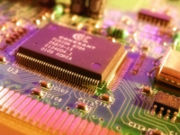Fundamental resources/print
Intro
So what have we got to work with? Mankind's fundamental resources are material, energy, intelligence and information. In reality they are all so enormously abundant that it's incredible to think that there are people in this world who are still going without the basic human necessities.In the past a lack of technology could be considered a significant cause of scarcity but that is certainly not a reason any more. Despite common perceptions, there is no actual lack of material or energy available to us. Emerging methods of co-operation and advanced automation have the potential to unlock these resources to provide a good standard of living in all parts of the world, while causing minimal harm to the natural environment - a combination that although is hard to imagine today and might appear at first glance to be contradictory, is very much possible.
An important trend in technological progress is the tendency of products and processes to steadily become more effective while using less material and energy – i.e. doing more with less – something that Buckminster Fuller  termed ephemeralization
termed ephemeralization  .
.
Contents
Material
Air, water and the twenty most abundant elements in the Earth's crust provide almost all the material needed to create the multitude of machines and goods that mankind requires: food, drugs, houses, vehicles, robots, industrial machinery, computers, consumer goods and so on.
Extracting these plentiful elements (and their compounds) to create useful material essentially involves energy (which is also plentiful) and the right processing methods. From a technical point of view there is practically no limit to the volume of material we could extract and make use of, if we so wished, even while minimally disrupting complex and fragile ecosystems. The reserves of raw materials needed to sustain civilisation are simply not going to run out, because the entire Earth's crust  is made up of them. However this is no excuse to be unnecessarily wasteful in our consumption. Advanced recycling will reduce the need to extract material from the ground and more efficient design will allow us to do more with less
is made up of them. However this is no excuse to be unnecessarily wasteful in our consumption. Advanced recycling will reduce the need to extract material from the ground and more efficient design will allow us to do more with less  .
.
The point is that any existing material scarcity actually has little to do with the reserves at our disposal.

Energy
Humanity consumes 15 terawatts of energy[1] and this is projected to rise to about 30 terawatts. This is a tiny amount of energy compared to what is available around us: 72 terawatts of available wind energy at ground level[2], 150 terawatts in the jet streams[3], 44.2 terawatts of geothermal energy [4], 2 terawatts of easily-exploitable wave power[5] and 174,000 terawatts of solar energy[6]. We clearly have tens of thousands of times the energy we need, the key is our ability to harness this energy. This article explores existing and emerging technologies for doing this.
Steadily increasing energy efficiency  due to improved system design and increasing cultural awareness should become a significant factor in our energy usage.
due to improved system design and increasing cultural awareness should become a significant factor in our energy usage.
The issue currently is monetary economics. The bottom line is that with the current economic framework it is still 'cheaper' to pump oil out of the ground and burn it to produce power than use other more plentiful, renewable and environmentally benign sources. These alternative energy sources are sitting right in front of us waiting to be harnessed. It may be that open-source methods can bypass the incumbent economic system to enable plentiful, environmentally-friendly power.
Human intelligence
Some people may suggest this as the one fundamental resource that really is in short supply...We just haven't been using it as efficiently as we could be. Currently with activities such as design and engineering only relatively small groups of people collaborate in any meaningful way. Research and development — whether of scientific projects, products, services, or modern business processes — is usually done behind closed doors and the results carefully hidden. This leads to reduplication of effort and of skilled cognitive work. As a result, progress is much slower than it could be. Problems such as a cure for cancer concern us all and it is a terrible waste to have multiple groups of scientists working on the problem in isolation from each other, hiding their results so that their company will profit when the solution is found.
Machine intelligence
On the machine side, intelligence is increasing exponentially and should continue to do so for many years to come (see Moore's law ). Not only are the total number of information processing units multiplying rapidly, but the relative computing power of each one is increasing exponentially too.
). Not only are the total number of information processing units multiplying rapidly, but the relative computing power of each one is increasing exponentially too.
On top of that algorithms and programming techniques are improving all the time to make more effective use of the hardware, as are distributed computing  techniques which are able to make use of idle processor time between connected units.
techniques which are able to make use of idle processor time between connected units.
The ever increasing sophistication and capability of computers mean that progressively more complex tasks can become automated. 
Information
There has never been more information freely available than there is now. We are now at a phase of civilisation where information costs almost nothing to reproduce or transmit. It is so abundant and readily available that it is finding useful and accurate information that has become the important thing.One significant aspect is that information can now completely describe the physical structure of man-made items, and can be communicated to automated fabrication machines which can then manufacture the product, reducing the requirement to transport material goods great distances to the end user, as happens generally now. Most of the journey will effectively be spent as information travelling at the speed of light. (See section on turning virtual designs into physical objects).

See also





